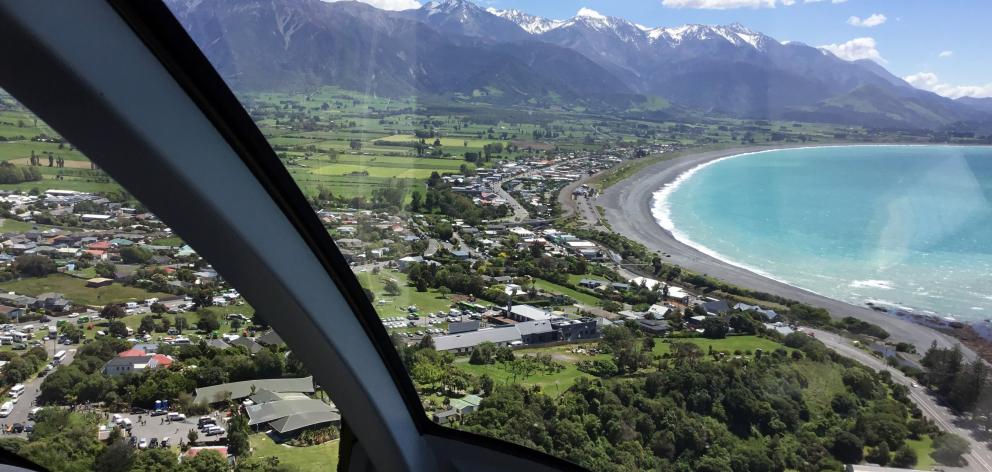
It's a big job, whichever way you cut it.
Reclining at a picnic table in front of his beachfront Rakautara home, welder and amateur videographer Barry Campbell has a frontrow seat to watch the action.
Five helicopters buzz like dragonflies, tailing monsoon buckets. They drop hundreds of litres of seawater from the sparkling ocean, internationally-famed for its blue whales and dolphins, onto the giant landslides blocking State Highway One north of Kaikoura.
Boulders tumble down the cliffsides. A rock the size of a softball, one geotech engineer tells me, can gather enough momentum to crash through a digger cab.
And there are diggers everywhere, picking, raking, grading the debris on nine massive landslips that were created by the magnitude-7.8 earthquake of November 14 last year.
Around 350,000 - 400,000 cubic metres of earth came down on a 40km stretch of road between Mangamaunu and Clarence during the violent shaking that also claimed two lives.
Four months on, the road - State Highway One, the main arterial route linking Picton and Christchurch, the lifeline of the South Island - is a hive of activity.
Working with the choppers and diggers, are engineers, dump truck drivers, abseiling daredevils, arborists, and an array of contractors.
Spotters wearing high vis and hard hats look out for falling dangers, intermingled with the staggeringly beautiful landscape of native bush, resplendent with bird song not drowned out by the usual traffic. Surfers catch curling waves.
Yesterday, orcas chased seals in Half Moon Bay. Workers hope they didn't snare 'Neil the Seal', their friendly flippered visitor.
In a New Zealand first, remote-controlled diggers operate on the most risky sites around Slip 6 and Slip 7, taking out the risk of injury or death.

Cameras have been installed on the "active slips" so officials can remotely keep an eye out in bad weather, without the need to scramble the fuel-thirsty choppers.
Makeshift worksites are dotted along the closed highway, with shipping containers and portacabins making for site offices and smoko rooms.
It's a "top down" approach for the unprecedented $2 billion repair job, New Zealand Transport Agency (NZTA) earthquake recovery manager Steve Mutton said.
Once the helicopters have sluiced loose debris, the abseilers drop in and pick off the rest.
Then diggers create platforms to start peeling off the rocks, dirt, and trees down to near sea level.
"The challenges are huge," Mutton said.
"We're working on massive slips... some 300m high. There's loose rocks, there's rubble coming down all the time so safety is really important for us.
"We've got a beautiful coastline one side and sheer cliffs on the other, so we need to tread lightly with the environment."
At Half Moon Bay, a stretch of railway track, concrete sleepers and all, has been whipped like spaghetti and splayed metres from its home.
But KiwiRail project director Walter Rushbrook reckons it looks worse than it is.
Once the debris has been cleared and the railway's foundations re-established, the track will be moved back into place.
"It's relatively easy," he said.
Late next month, work trains will start shifting ballast and supplies on the lines from the north and south.
Locals better soon start looking for trains again.
If more than 15mm of rain falls, the sites shut down.
State Highway 1 south of Kaikoura succumbed to downfalls earlier in the week and was out of action for a few days. A 50-tonne monster boulder came crashing down.
But the crews otherwise work around the clock. Only Waitangi Day has resulted in the picturesque strip of highway fall silent this year.
Up until this week, Campbell and the other residents of tiny Rakautara have been trapped between two landslides.
They had to walk through railway tunnels and over seaside boulders to arrive at a makeshift car park before driving into Kaikoura for supplies. Often they used wheelbarrows to ferry their food through the darkened tunnels.
"It was a wee bit of a pain on a bad day, but at least you could do it," Campbell said.
He had been enjoying the peace and quiet, until now. Operations are ramping up.
Mutton is adamant road and rail will be restored by the end of the year.
Campbell, who has filmed hours of helicopter work, marvelling at the skill of the pilots operating in busy airspace and tight areas, reckons they are on track.
"It won't take long," he says.
"Four months have gone already and if they say it's going to take a year, it's not that long to go. We're happy with it."










